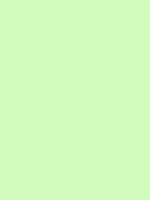#d1fabd Color Information
In a RGB color space, hex #d1fabd is composed of 82% red, 98% green and 74.1% blue. Whereas in a CMYK color space, it is composed of 16.4% cyan, 0% magenta, 24.4% yellow and 2% black. It has a hue angle of 100.3 degrees, a saturation of 85.9% and a lightness of 86.1%. #d1fabd color hex could be obtained by blending #ffffff with #a3f57b. Closest websafe color is: #ccffcc.
-
- R 82
- G 98
- B 74
-
- C 16
- M 0
- Y 24
- K 2
● #d1fabd color description : Very soft green.
#d1fabd Color Conversion
The hexadecimal color #d1fabd has RGB values of R:209, G:250, B:189 and CMYK values of C:0.16, M:0, Y:0.24, K:0.02. Its decimal value is 13761213.
| Hex triplet | d1fabd | #d1fabd |
|---|---|---|
| RGB Decimal | 209, 250, 189 | rgb(209,250,189) |
| RGB Percent | 82, 98, 74.1 | rgb(82%,98%,74.1%) |
| CMYK | 16, 0, 24, 2 | |
| HSL | 100.3°, 85.9, 86.1 | hsl(100.3,85.9%,86.1%) |
| HSV (or HSB) | 100.3°, 24.4, 98 | |
| Web Safe | ccffcc | #ccffcc |
| CIE-LAB | 94.141, -23.937, 25.029 |
|---|---|
| XYZ | 69.663, 85.599, 60.993 |
| xyY | 0.322, 0.396, 85.599 |
| CIE-LCH | 94.141, 34.633, 133.722 |
| CIE-LUV | 94.141, -20.194, 40.406 |
| Hunter-Lab | 92.52, -27.508, 25.677 |
| Binary | 11010001, 11111010, 10111101 |
Color Schemes with #d1fabd
Alternatives to #d1fabd
Below, you can see some colors close to #d1fabd. Having a set of related colors can be useful if you need an inspirational alternative to your original color choice.
#d1fabd Preview
This text has a font color of #d1fabd.
<span style="color:#d1fabd;">Text here</span>This paragraph has a background color of #d1fabd.
<p style="background-color:#d1fabd;">Content here</p>This element has a border color of #d1fabd.
<div style="border:1px solid #d1fabd;">Content here</div>.text {color:#d1fabd;}.background {background-color:#d1fabd;}.border {border:1px solid #d1fabd;}Shades and Tints of #d1fabd
A shade is achieved by adding black to any pure hue, while a tint is created by mixing white to any pure color. In this example, #030701 is the darkest color, while #f7fef4 is the lightest one.
-
#030701
#030701rgb(3,7,1) -
#0a1902
#0a1902rgb(10,25,2) -
#102b03
#102b03rgb(16,43,3) -
#173e05
#173e05rgb(23,62,5) -
#1e5006
#1e5006rgb(30,80,6) -
#256207
#256207rgb(37,98,7) -
#2c7409
#2c7409rgb(44,116,9) -
#33870a
#33870argb(51,135,10) -
#3a990c
#3a990crgb(58,153,12) -
#41ab0d
#41ab0drgb(65,171,13) -
#48bd0e
#48bd0ergb(72,189,14) -
#4fd010
#4fd010rgb(79,208,16) -
#56e211
#56e211rgb(86,226,17)
-
#5fee19
#5fee19rgb(95,238,25) -
#6bef2b
#6bef2brgb(107,239,43) -
#78f03d
#78f03drgb(120,240,61) -
#85f250
#85f250rgb(133,242,80) -
#91f362
#91f362rgb(145,243,98) -
#9ef474
#9ef474rgb(158,244,116) -
#abf686
#abf686rgb(171,246,134) -
#b8f799
#b8f799rgb(184,247,153) -
#c4f9ab
#c4f9abrgb(196,249,171) -
#d1fabd
#d1fabdrgb(209,250,189) -
#defbcf
#defbcfrgb(222,251,207) -
#eafde1
#eafde1rgb(234,253,225) -
#f7fef4
#f7fef4rgb(247,254,244)
Tones of #d1fabd
A tone is produced by adding gray to any pure hue. In this case, #dbdcdb is the less saturated color, while #d0fdba is the most saturated one.
-
#dbdcdb
#dbdcdbrgb(219,220,219) -
#dadfd8
#dadfd8rgb(218,223,216) -
#d9e1d6
#d9e1d6rgb(217,225,214) -
#d9e4d3
#d9e4d3rgb(217,228,211) -
#d8e7d0
#d8e7d0rgb(216,231,208) -
#d7eacd
#d7eacdrgb(215,234,205) -
#d6eccb
#d6eccbrgb(214,236,203) -
#d5efc8
#d5efc8rgb(213,239,200) -
#d4f2c5
#d4f2c5rgb(212,242,197) -
#d3f5c2
#d3f5c2rgb(211,245,194) -
#d2f7c0
#d2f7c0rgb(210,247,192) -
#d1fabd
#d1fabdrgb(209,250,189) -
#d0fdba
#d0fdbargb(208,253,186)
Color Blindness Simulator
Below, you can see how #d1fabd is perceived by people affected by a color vision deficiency. This can be useful if you need to ensure your color combinations are accessible to color-blind users.
